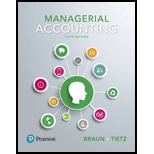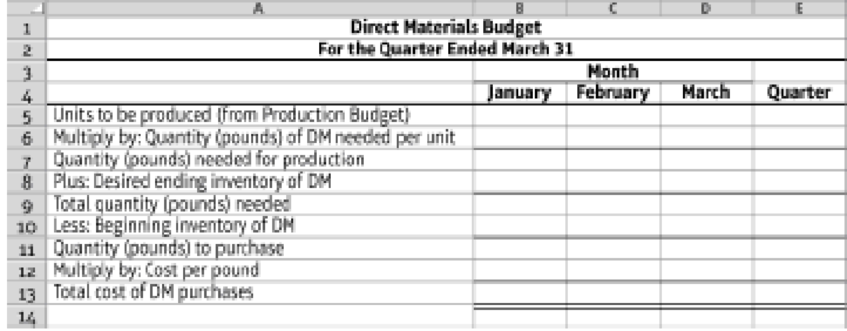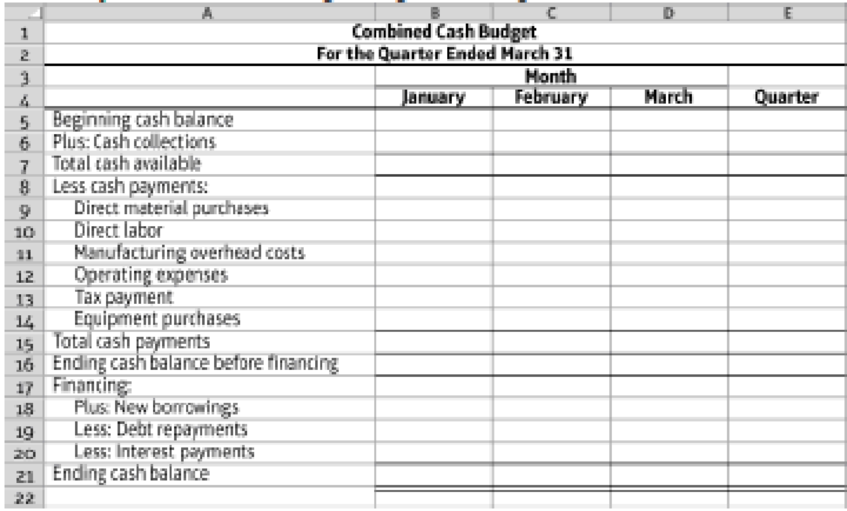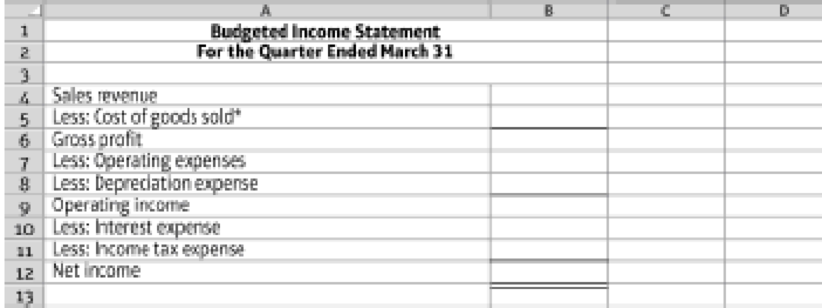
Managerial Accounting (5th Edition)
5th Edition
ISBN: 9780134128528
Author: Karen W. Braun, Wendy M. Tietz
Publisher: PEARSON
expand_more
expand_more
format_list_bulleted
Concept explainers
Textbook Question
Chapter 9, Problem 9.57AP
Comprehensive budgeting problem (Learning Objectives 2 & 3)
Martin Manufacturing is preparing its
| Current Assets as of December 31 (prior year): | |
| Cash | $ 4.500 |
| $ 47,000 |
| Inventory | $ 15,700 |
| Property, plant, and equipment, net | $120,000 |
| Accounts payable | $ 42,400 |
| Capital stock | $124,000 |
| $23,100 |
- a. Actual sales in December were $70,000. Selling price per unit is projected to remain stable at $10 per unit throughout the budget period. Sales for the first five months of the upcoming year are budgeted to be as follows:
| January | $ 80,000 |
| February | $ 92,000 |
| March | $ 99,000 |
| April | $ 97,000 |
| May | $ 85,000 |
- b. Sales are 30% cash and 70% credit. All credit sales are collected in the month following the sale.
- c. Martin Manufacturing has a policy stating that each month’s ending inventory of finished goods should be 25% of the following month’s sales (in units).
- d. Of each month’s direct materials purchases, 20% are paid for in the month of purchase, while the remainder is paid for in the month following purchase. Two pounds of direct material is needed per unit at $2 per pound. Ending inventory of direct materials should be 10% of next month’s production needs.
- e. Most of the labor at the manufacturing facility is indirect, but there is some direct labor incurred. The direct labor hours per unit is 0.01. The direct labor rate per hour is $12 per hour. All direct labor is paid for in the month in which the work is performed. The direct labor total cost for each of the upcoming three months is as follows:
| January | $996 |
| February | $1,125 |
| March | $1,182 |
- f. Monthly manufacturing
overhead costs are $5,000 for factory rent, $3,000 for other fixed manufacturing expenses, and $1.20 per unit for variable manufacturing overhead. Nodepreciation is included in these figures. All expenses are paid in the month in which they are incurred. - g. Computer equipment for the administrative offices will be purchased in the upcoming quarter. In January, Martin Manufacturing will purchase equipment for $5,000 (cash), while February’s cash expenditures will be $12,000 and March’s cash expenditures will be $16,000.
- h. Operating expenses are budgeted to be $1.00 per unit sold plus fixed operating expenses of $1,000 per month. All operating expenses are paid in the month in which they are incurred. No depreciation is included in these figures.
- i. Depreciation on the building and equipment for the general and administrative offices is budgeted to be $4,600 for the entire quarter, which includes depreciation on new acquisitions.
- j. Martin Manufacturing has a policy that the ending cash balance in each month must be at least $4,000. It has a line of credit with a local bank. The company can borrow in increments of $1,000 at the beginning of each month, up to a total outstanding loan balance of $150,000. The interest rate on these loans is 1% per month simple interest (not compounded). The company would pay down on the line of credit balance in increments of $1,000 if it has excess funds at the end of the quarter. The company would also pay the accumulated interest at the end of the quarter on the funds borrowed during the quarter.
- k. The company’s income tax rate is projected to be 30% of operating income less interest expense. The company pays $10,000 cash at the end of February in estimated taxes.
Requirements
- 1. Prepare a schedule of cash collections for January, February, and March, and for the quarter in total. Use the following format:

9.4-49 Full Alternative Text
- 2. Prepare a production budget, using the following format:

9.4-50 Full Alternative Text
*Hint: Unit sales = Sales in dollars/Selling price per unit
- 3. Prepare a direct materials budget, using the following format:

9.4-51 Full Alternative Text
- 4. Prepare a cash payments budget for the direct material purchases from Requirement 3, using the following format. (Use the accounts payable balance at December 31 of prior year for the prior month payment in January.)

9.4-52 Full Alternative Text
- 5. Prepare a cash payments budget for direct labor, using the following format:

9.4-53 Full Alternative Text
- 6. Prepare a cash payments budget for manufacturing overhead costs, using the following format:

9.4-54 Full Alternative Text
- 7. Prepare a cash payments budget for operating expenses, using the following format:

9.4-55 Full Alternative Text
- 8. Prepare a combined
cash budget , using the following format:

9.4-56 Full Alternative Text
- 9. Calculate the budgeted
manufacturing cost per unit, using the following format (assume that fixed manufacturing overhead is budgeted to be $0.80 per unit for the year):

9.4-57 Full Alternative Text
- 10. Prepare a
budgeted income statement for the quarter ending March 31, using the following format:

9.4-58 Full Alternative Text
*Hint: Cost of goods sold = Budgeted cost of manufacturing one unit × Number of units sold
Expert Solution & Answer
Want to see the full answer?
Check out a sample textbook solution
Students have asked these similar questions
Provide correct answer financial accounting question
Tag. General Account
General Account
Chapter 9 Solutions
Managerial Accounting (5th Edition)
Ch. 9 - (Learning Objective 1) Which term describes the...Ch. 9 - (Learning Objective 1) Benefits of budgeting...Ch. 9 - Prob. 3QCCh. 9 - Prob. 4QCCh. 9 - Prob. 5QCCh. 9 - Prob. 6QCCh. 9 - Prob. 7QCCh. 9 - Prob. 8QCCh. 9 - Prob. 9QCCh. 9 - Prob. 10QC
Ch. 9 - Short Exercises S9-1 Order of preparation and...Ch. 9 - Explain why companies use zero-based budgeting...Ch. 9 - Understanding key terms and definitions (Learning...Ch. 9 - Sales Budget (Learning Objective 2) Jefferson...Ch. 9 - Production budget (Learning Objective 2) Nichols...Ch. 9 - Direct materials budget (Learning Objective 2)...Ch. 9 - Prob. 9.7SECh. 9 - Prob. 9.8SECh. 9 - Prob. 9.9SECh. 9 - Prob. 9.10SECh. 9 - Prob. 9.11SECh. 9 - Cash payments budget (Learning Objective 3) Finley...Ch. 9 - Cash budget (Learning Objective 3) SaveCo...Ch. 9 - Prob. 9.14SECh. 9 - Prob. 9.15SECh. 9 - Identify ethical standards violated (Learning...Ch. 9 - Prob. 9.17AECh. 9 - Sales budget for a retail organization (Learning...Ch. 9 - Prob. 9.19AECh. 9 - Production budget (Learning Objective 2) Hoffman...Ch. 9 - Direct materials budget (Learning Objective 2)...Ch. 9 - Production and direct materials budgets (Learning...Ch. 9 - Direct labor budget (Learning Objective 2)...Ch. 9 - Manufacturing overhead budget (Learning Objective...Ch. 9 - Operating expenses budget and an income statement...Ch. 9 - Budgeted income statement (Learning Objective 2)...Ch. 9 - Prob. 9.27AECh. 9 - Cash collections budget (Learning Objective 3)...Ch. 9 - Cash payments budget (Learning Objective 3) The...Ch. 9 - Prob. 9.30AECh. 9 - Prob. 9.31AECh. 9 - Budgeted balance sheet (Learning Objective 3) Use...Ch. 9 - Prob. 9.33AECh. 9 - Prob. 9.34AECh. 9 - Cost of goods sold, inventory, and purchases...Ch. 9 - Cost of goods sold, inventory, and purchases...Ch. 9 - Prob. 9.37BECh. 9 - Prob. 9.38BECh. 9 - Prob. 9.39BECh. 9 - Prob. 9.40BECh. 9 - Direct materials budget (Learning Objective 2) Moe...Ch. 9 - Prob. 9.42BECh. 9 - Prob. 9.43BECh. 9 - Manufacturing overhead budget (Learning Objective...Ch. 9 - Prob. 9.45BECh. 9 - Prob. 9.46BECh. 9 - Prob. 9.47BECh. 9 - Prob. 9.48BECh. 9 - Prob. 9.49BECh. 9 - Combined cash budget (Learning Objective 3)...Ch. 9 - Sales and cash collections budgets (Learning...Ch. 9 - Prob. 9.52BECh. 9 - Prob. 9.53BECh. 9 - Prob. 9.54BECh. 9 - Prob. 9.55BECh. 9 - Prob. 9.56BECh. 9 - Comprehensive budgeting problem (Learning...Ch. 9 - Cash budgets under two alternatives (Learning...Ch. 9 - Comprehensive summary problem (Learning Objectives...Ch. 9 - Prob. 9.60APCh. 9 - Cash budgets (Learning Objective 3) Elis...Ch. 9 - Prob. 9.62APCh. 9 - Cost of goods sold, inventory, and purchases...Ch. 9 - Prob. 9.64APCh. 9 - Problems Group B P9-65B Comprehensive budgeting...Ch. 9 - Cash budgets under two alternatives (Learning...Ch. 9 - Comprehensive summary problem (Learning Objectives...Ch. 9 - Prob. 9.68BPCh. 9 - Cash budgets (Learning Objective 3) Ivans...Ch. 9 - Combined cash budget and a budgeted balance sheet...Ch. 9 - Prob. 9.71BPCh. 9 - Prepare comprehensive budgets for a retailer...Ch. 9 - Prob. 9.73SCCh. 9 - Discussion Questions 1. The sales budget is the...Ch. 9 - Budgeting for a Single Product In this activity,...Ch. 9 - Ethics and budgetary slack (Learning Objectives 1,...Ch. 9 - Prob. 9.77ACT
Knowledge Booster
Learn more about
Need a deep-dive on the concept behind this application? Look no further. Learn more about this topic, accounting and related others by exploring similar questions and additional content below.Similar questions
- On January 1, Lightbulbs, Inc. issued 5-year bonds with a $400,000 face value. The bonds have a contract rate of 6% and were issued at 96. What is the bond interest expense on the first semi-annual interest payment date using straight-line amortization?arrow_forwardWhat will be the company's contribution margin?arrow_forwardNeed help with this accounting questionsarrow_forward
- Hi teacher please help me this question general accountingarrow_forwardDoes the pattern of variances suggest Pro Fender's managers have been making trade-offs?arrow_forwardGreen Co. incurs a cost of $15 per pound to produce Product X, which it sells for $26 per pound. The company can further process Product X to produce Product Y. Product Y would sell for $30 per pound and would require an additional cost of $10 per pound to be produced. The differential cost of producing Product Y is: a. $15 per pound b. $26 per pound c. $30 per pound d. $10 per poundarrow_forward
- Financial Accountingarrow_forwardWhen a company pays cash for a truck, what is the effect on the accounting equation for that company? A. Increase assets and increase liabilities. B. Decrease assets and decrease liabilities. C. Increase assets and increase equity. D. No net change.arrow_forwardNO WRONG ANSWERarrow_forward
- Baltimore Company experienced an increase in total assets of $12,500 during the current year. During the same time period, total liabilities increased $9,100. Shareholders made no investments during the and no dividends were paid. How much was Baltimore's net income? yeararrow_forwardWhich of the following statements are true with regard to asset accounts? a. Assets are on the left side of the accounting equation. b. Assets are the right-side of the accounting equation. c. Assets are increased with debits Assets are increased with credits. d. Assets are decreased with debits Assets are decreased with credits.arrow_forwardFinancial accounting questionarrow_forward
arrow_back_ios
SEE MORE QUESTIONS
arrow_forward_ios
Recommended textbooks for you
- Principles of Accounting Volume 2AccountingISBN:9781947172609Author:OpenStaxPublisher:OpenStax College

Principles of Accounting Volume 2
Accounting
ISBN:9781947172609
Author:OpenStax
Publisher:OpenStax College
Responsibility Accounting| Responsibility Centers and Segments| US CMA Part 1| US CMA course; Master Budget and Responsibility Accounting-Intro to Managerial Accounting- Su. 2013-Prof. Gershberg; Author: Mera Skill; Rutgers Accounting Web;https://www.youtube.com/watch?v=SYQ4u1BP24g;License: Standard YouTube License, CC-BY